Eastern monarch butterfly population sees second largest decline on record
The monarch butterflies that breed east of the Rocky Mountains took a hit in population compared to last year. Scientists fear that the population is too low for the species to sustain itself.
Eastern monarch butterfly population less than half of last year
Eastern monarch butterflies overwinter in Central Mexico. Each year, surveyors estimate how many millions of butterflies are crowded on trees across the area. This winter's count came out 59% lower than last year's.
MEXICO CITY – The eastern monarch butterfly population was halved in just one year, finds the World Wildlife Fund, tasked with counting butterflies while they overwinter in Central Mexico.
Last winter, monitors found butterflies clustered on 5.5 acres of forest. This year, the population occupies only 2.2 acres of forest, a 59% drop.
"This makes 2023-24 the second-worst year ever recorded," said the Xerces Society in a statement. "The lowest year was in 2013-14 when only 0.67 hectares (1.6 acres) were occupied."
FAST FACTS ABOUT MONARCH BUTTERFLIES
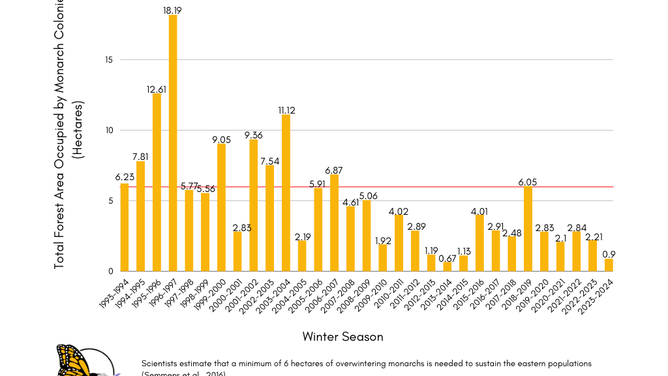
Naturalists track the eastern monarch butterfly populations starting in 1993. The measure is hectares. One hectare is about 2.5 acres.
(Monarch Joint Venture / FOX Weather)
Record-taking started in 1993. The population has varied from the 2013-14 low to a high of 45 acres in 1996-97.
"Fewer monarchs hibernating in their traditional forest habitat in Mexico greatly concerns all of us," said Jorge Rickards of the WWF Mexico. "This is not the first time we've observed changes in the locations of the largest monarch colonies. It's telling us that we need to intensify conservation and restoration measures not only in the Monarch Butterfly Biosphere Reserve but also outside of it."
The 2.2 acres keep scientists anxious because it is well below the 14.8-acre minimum recommended threshold for overwintering monarchs, according to the Monarch Joint Venture. Research suggests that populations occupying less than 14.8 acres can't sustain the population and migration.
PESTICIDE-FREE MILKWEED FOR BUTTERFLY GARDENS MAY BE HARD TO FIND AT NURSERIES, NEW STUDY FINDS
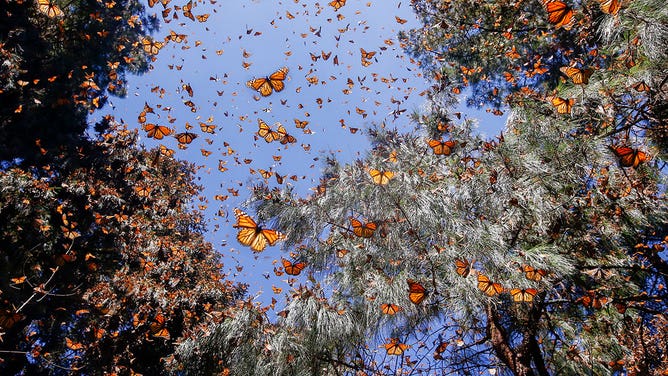
File: Monarch butterflies are seen in one of their wintering grounds in Angangueo, Michoacan State, Mexico.
(Sylvain CORDIER/Gamma-Rapho / Getty Images)
"The current population size remains lower than the target of 6 hectares (14.8 acres), driving continued concern for the migration and necessitating increased conservation action," said the Monarch Joint Venture blog.
How many butterflies live in an acre?
Scientists found that while the butterfly density varies across the forest, 20-30 million insects generally occupy one hectare (2.47 acres) of forest. Researchers assume 21.1 million butterflies occupy the one hectare.
This winter's population works out to just under 20 million butterflies. That sounds like a lot until you compare the number to the 383 million monarchs counted in 1995-66 or the over 126 million insects needed to sustain the long-term population.
WHY WE SHOULD THANK A BUG FOR DINNER
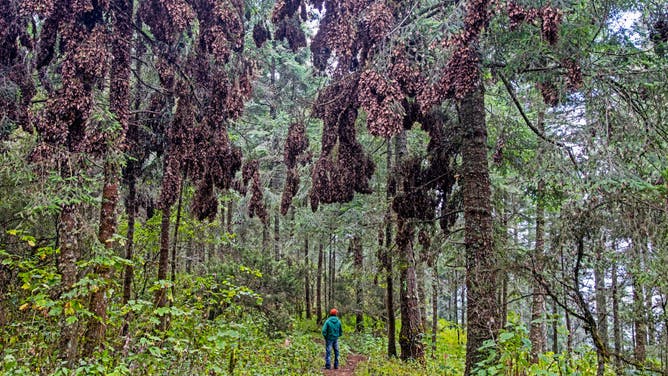
File: Clusters of monarchs. Monarch butterflies (Danaus plexippus) in tree at the Monarch Butterfly Biosphere Reserve near Angangueo, Michoacan, Mexico.
(Marica van der Meer/Arterra/Universal Images Group / Getty Images)
"The annual survey is considered a benchmark for the overall abundance of the species," explained the World Wildlife Fund in a statement. "Experts measure the area of forest in which monarch butterflies hibernate each winter, providing a scientific indicator of their population status."
Why are populations waning?
The WWF points to changing climate patterns like El Niño and La Niña in monarch breeding grounds across the U.S. and Canada, triggering drought and heat waves as a likely culprit. The heat and lack of water took a toll on milkweed, the only plant on which the monarchs lay their eggs.
Land use changes across the U.S. and widespread herbicide use also cut down on milkweed numbers and nectar plants that feed the butterflies, the WWF added.
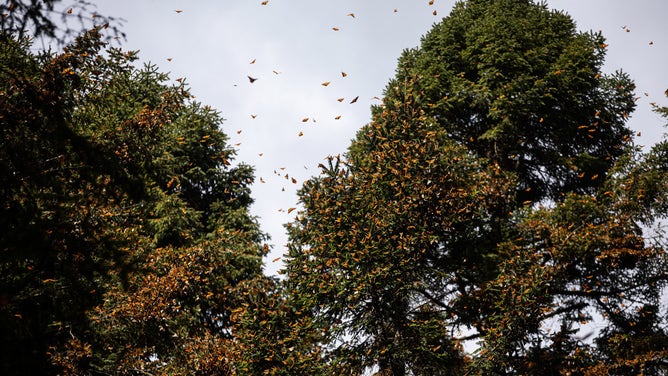
File: Hundreds of Monarch butterflies (Danaus Plexippus) rest on branches while others fly in El Rosario Butterfly Sanctuary, in Michoacan State, Mexico on January 31, 2022.
(Daniel Cardenas/Anadolu Agency / Getty Images)
"I am very concerned with the monarch numbers out of Mexico this year," said Scott Black, the executive director of the Xerces Society for Invertebrate Conservation, which manages the Western Monarch Count, in a statement. "We need to move forward on listing monarchs under the Endangered Species Act in the U.S. to maximize protection and restoration of habitat across the monarch’s range and take action to protect these animals from toxic pesticides."
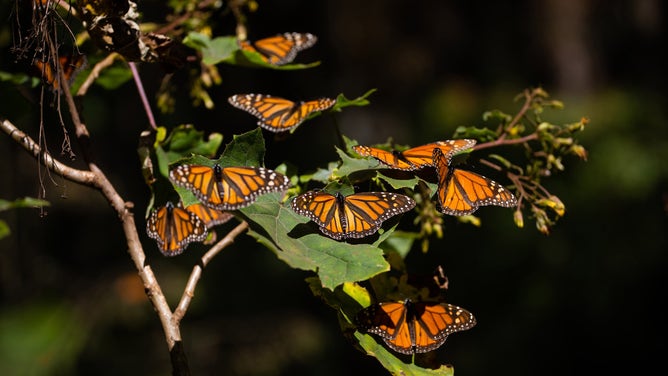
File: Monarch butterflies (Danaus Plexippus) rest on a plant in El Rosario Butterfly Sanctuary, in Michoacan State, Mexico on January 31, 2022.
( Daniel Cardenas/Anadolu Agency / Getty Images)
The western monarch population struggled this winter as well. The population dropped by 30% in a year. Xerces biologists suggest the parade of atmospheric river storms last winter and spring killed butterflies and destroyed overwintering forests.
Volunteers count butterflies, not acres of forest, for the western monarch population. Numbers are much smaller than those of the eastern brethren. The 2023-24 estimate produced 233,329 monarchs that breed west of the Rockies.
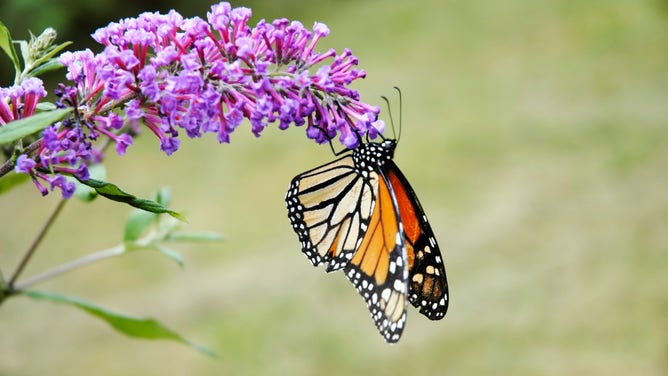
File: A monarch on a butterfly bush.
(MyLoupe/UIG )
Some monarchs migrate up to 3,000 miles
Monarch butterflies fascinate the young and old alike, live and breed east of the Rocky Mountains and migrate to Mexico when the weather cools. The insects return to the same area, sometimes the same tree, year after year.
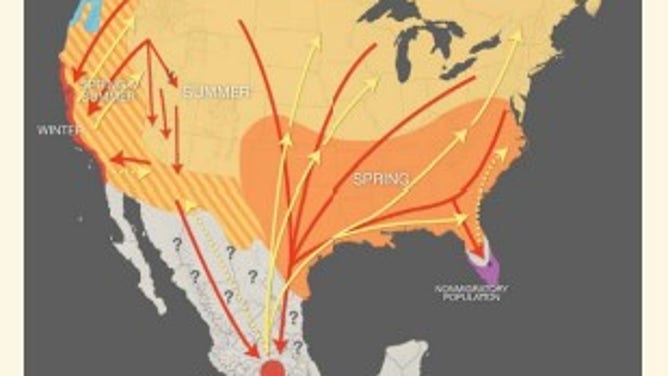
Western monarch butterflies west of the Rocky Mountains migrate to the California coast for winter. Eastern monarchs migrate to Mexico.
(The Xerces Society)
The cold-blooded animals huddle together by the thousands on trees to keep warm. The beauties conserve energy to ready themselves for migration.
"Monarchs require a large and healthy forest mass to protect them from winds, rain, and low temperatures that are common at night in these forests," said the WWF.
They eat when they can but fall into a stupor when the temperature is cool, like in the morning. That is the perfect time to count the population when they are all still.
